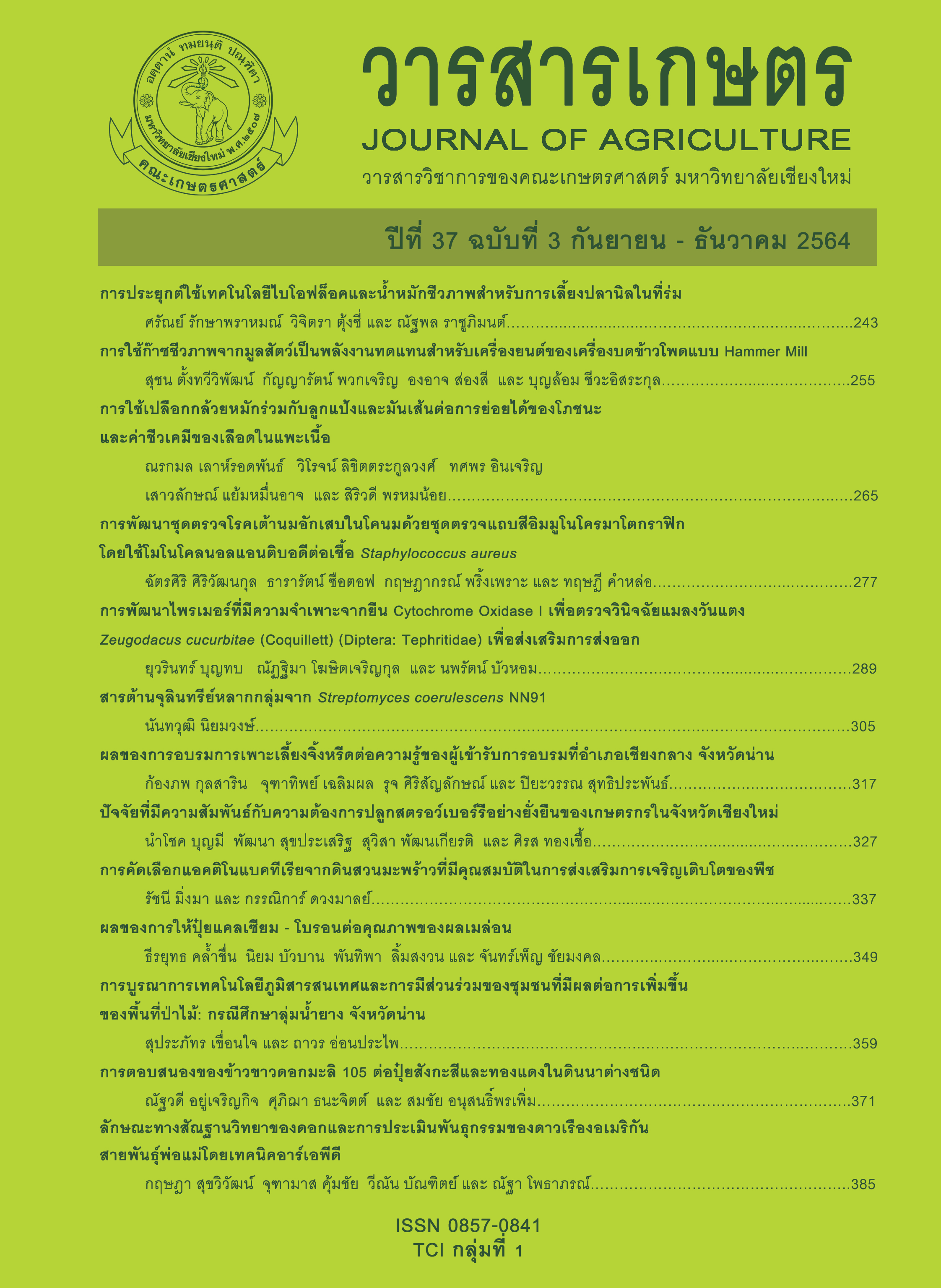การประยุกต์ใช้เทคโนโลยีไบโอฟล็อคและน้ำหมักชีวภาพสำหรับการเลี้ยงปลานิลในที่ร่ม
Main Article Content
บทคัดย่อ
งานวิจัยนี้มีวัตถุประสงค์เพื่อศึกษาการเจริญเติบโต อัตราการรอดตาย และอัตราการแลกเนื้อของปลานิล ขนาด 2.7 - 3 เซนติเมตร และการวิเคราะห์คุณภาพน้ำในระบบการเลี้ยงรูปแบบต่าง ๆ โดยวางแผนการทดลองแบบสุ่มอย่างสมบูรณ์ กำหนดเป็น 4 ชุดการทดลอง ชุดการทดลองละ 3 ซ้ำ ได้แก่ ชุดการทดลองที่ 1 คือ การเลี้ยงปลานิลด้วยระบบปกติ (ชุดควบคุม) ชุดการทดลองที่ 2 การเลี้ยงปลานิลด้วยเทคโนโลยีไบโอฟล็อค ชุดการทดลองที่ 3 การเลี้ยงปลานิลด้วยน้ำหมักชีวภาพ และชุดการทดลองที่ 4 การเลี้ยงปลานิลด้วยระบบไบโอฟล็อคร่วมกับน้ำหมักชีวภาพ เป็นเวลา 8 สัปดาห์ เมื่อสิ้นสุดการทดลอง พบว่า การเลี้ยงปลานิลด้วยระบบไบโอฟล็อค (ชุดการทดลองที่ 2) เป็นระบบการเลี้ยงที่ดีที่สุด ส่งผลให้ปลานิลมีการเจริญเติบโตดี อัตราการรอดตายสูง อัตราการแลกเนื้อต่ำ และสามารถบำบัดแอมโมเนียได้โดยไม่ต้องเปลี่ยนถ่ายน้ำ ทำให้ประหยัดต้นทุน แต่อาจจะต้องควบคุมปริมาณสารแขวนลอยในน้ำไม่ควรเกิน 500 มิลลิกรัมต่อลิตร และควบคุมระดับ pH ไม่ให้ต่ำกว่า 6.5 และพบว่า ตะกอนจุลินทรีย์ มีโปรตีน 21 % ของน้ำหนักแห้ง มีแพลงก์ตอนหลายชนิด ได้แก่ Vorticella sp., Paramecium sp., Euchlanis sp., Rotaria sp., Amoeba sp., Arcella sp., Scenedesmus sp., Euglypha sp., rotifers, Brachionus sp., Centropysis sp., Prorodon sp., Trichocerca sp. และ Bdelloidea sp. ซึ่งเป็นอาหารที่ปลานิลสามารถกินได้ตลอดเวลา
Article Details
เอกสารอ้างอิง
Association of Official Analytical Chemists. 1999. Official Methods of Analysis, 16th ed. Association of Official Analytical Chemists, Washington, D.C.
Azim, M.E. and D.C. Little. 2008. The biofloc technology (BFT) in indoor tanks: Water quality, biofloc composition, and growth and welfare of Nile tilapia (Oreochromis niloticus). Aquaculture 283: 29-35.
Coastal Aquaculture Department of Fisheries. 2008. Methods for analyzing water quality for coastal aquaculture. (2nd printing). Agricultural Co-Operative Federation of Thailand Ltd. 233 p. (in Thai)
Comesat, A., Y. Lobbumrung and T. Buabarn. 2018. Culture of Nile Tilapia (Oreochromis niloticus) with biofloc technology. B.S. Special problem. Faculty of Agricultural Technology and Industrial Technology, Nakhon Sawan Rajabhat University, Nakhon Sawan. (in Thai)
Faizullah, M., C.B.T. Rajagopalsamy, B. Ahilan and T. Francis. 2015. Impact of biofloc technology on the growth of goldfish young ones. Indian Journal of Science and Technology 8(13), doi: 10.17845/ijst/2015/v8i13/54060.
Hmadhloo, S., S. Tanyaros and P. Phumee. 2013. Effect of C:N ratio in integrated culture of white shrimp (Litopenaeus vannamei) and Nile Tilapia (Oreochromis niloticus) using biofloc technology. Rajamangala University of Technology Srivijaya Research Journal 5(1): 96-106. (in Thai)
Madyod, S., S. Madyod, S. Wuthisuthimethavee, D. Chumthong, G. Jantasila, O. Nuanlaong, S. HnuChu and S. Bunrod. 2017. Application supplementation of immunostimulant in dried bio-flocs on survival rate of Nile tilapia infected with Streptococcus agalactiae, DMST 17129. pp. 18-26. In: Proceeding of the 9th Rajamangala University of Technology National Conference: Creative RMUT and Sustainable Innovation for Thailand 4.0. RMUT, Bangkok. (in Thai)
Mugwanya, M., M.A.O. Dawood, F. Kimera and H. Sewilam. 2021. Biofloc systems for sustainable production of economically Important aquatic species: A review. Sustainability 13(13): 7255, doi: 10.3390/su13137255
Nootong, K. 2008. Nitrogen treatment in closed-system aquaculture. King Mongkut’s Agricultural Journal 16(1): 11-20. (in Thai)
Ogello, E.O., S.M. Musa, C.M. Aura, J.O. Abwao and J.M. Munguti. 2014. An appraisal of the feasibility of tilapia production in ponds using biofloc technology: A review. International Journal of Aquatic Science 5(1): 21-39.
Promya, J. 2015. Biofloc system and the prototype organic Nile tilapia production for community enterprises Chiang Mai province. Research report. Maejo University, Chiang Mai. (in Thai)
Sittplangkoon, P., W. Pungrasmi and K. Noothong, 2012. Control of Inorganic Nitrogen Concentrations and Ammonium Removal Rates by Biological Sludge from Closed Aquaculture Cultivating System. pp. 317-323. In: Proceeding of the 9th National Kasetsart University Kamphaeng Saen Conference: “Follow the King's Footsteps, Kasetsart Kamphaeng Saen”, Bangkok. (in Thai)
Wang, G., E. Yu, J. Xie, D. Yu, Z. Li, W. Luo, L. Qiu and Z. Zheng. 2015. Effect of C/N ratio on water quality in zero-water exchange tanks and the biofloc supplementation in feed on the growth performance of crucian carp, Carassius auratus. Aquaculture 443: 98-104.
Wanakanapol, A. 2013. The investigation of carbon sources for produce biofloc in tilapia (Oreochromis niloticus L.) and hybrid catfish (Clarias gariepinus x Clarias macrocephalus) culture. Research report, Maejo University, Chiang Mai. 18 p. (in Thai)
Wongphonprateep, S., T. Nganwisuthiphan and K. Suntudkarn. 2017. Application of biofloc in Nile tilapia (Oreochromis niloticus) diet. Prawarun Agricultural Journal 14(2): 231-237. (in Thai)
Wood, C.M. 1993. Ammonia and urea metabolism and excretion. pp. 379-425. In: D.H. Evans (ed.). The Physiology of Fishes. CRC Press, Boca Raton.


